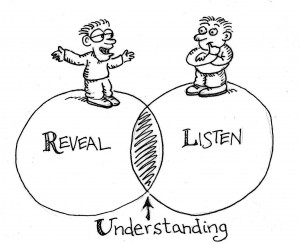Imagine this: It’s 9 o’clock at night, the house is quiet, and you’re in bed getting comfortable. Suddenly, you hear the friendly whistle of a twitter notification. You decide to check your phone “quickly” before going to sleep. An hour later, you’ve scrolled through all your socials and are seconds away from downloading a brain training app you saw on TikTok. Now, answer this: What made you click?

It stands to reason that what would influence a user (you) to click would be somewhat unique to that user. However, personalization has its bounds. So, social media sites use data sharing alongside their algorithms to keep your feed enticing to you, the consumer. According to Rob Sanders, digital marketing expert, social media platforms supply marketers with a vast amount of data to know what content is working and what isn’t. However, the personalization of your feed does not stop there. Marketers utilize aggregate data, collected from online purchases and website visits, alongside social engineering to keep you purchasing, downloading, and revisiting. This aggregate data can include statistics on customer demographics, such as who the person is, how and where they live, what they do, etc. It can also include behavior metrics like average age and number of transactions.
Aggregate Data, Algorithms, and Social Engineering = Influence
Does this mean if an advertisement is granted its 30 seconds of fame on Twitter, it’s guaranteed success? Not at all. But let’s say you recently started shopping for a gift for your sister. You come across a Twitter ad featuring your favorite fitness influencer, modeling a new line of Nike activewear. In fact, her shorts are the same ones your sister was begging for yesterday in the family group chat. Underneath the advertisement, you read the words “for limited time offer of 20% off, use code BFF20 today.” To a marketer, this ad has a higher probability of influencing a sale. That is because using common social engineering influence tactics like social proof or scarcity to elicit an emotion can be incredibly effective when paired with aggregate data.
As seen in this ad, marketers will cross-reference your browsing history against your sister’s simply because your phones were in the same GPS location. The result? The advertisement satisfied a need for a gift for your sister and more importantly, it elicited an emotional response.

Influencing Emotions
“People decide with their emotions, then justify with facts,” per marketing expert and Forward Focus president, Beth Williams. What better way to elicit an emotional response, like urgency, than artificial time constraints that lead to feelings of scarcity? Robert Cialdini, author of Pre-Suasion: A Revolutionary Way to Influence and Persuade once said “FOMO [Fear of Missing Out] is real, anything that plays to that fear–ticking clock emojis in an email marketing campaign, limited-time offers–can stoke that sense of urgency and that impulse to purchase.” Previously, the “limited time offer of 20% off” with the use of a discount code drove us to the site. What if, once the site was accessed, you saw text that reads “only 5 left in stock?” The fear of missing the sale might further the impulse to act now.
It’s easy to imagine that the tools and data meant to influence emotional responses in consumers can be used maliciously. However, as a company, it’s important to focus on eliciting a positive emotional response to ensure a good brand image. The difference between influence and manipulation, as defined by social-engineer.org, lies in the intention behind the exchange. “When the intent is to win at all costs without considering the effect on the target, we view this as paving the way to manipulation.” When the intent is positive, considerate of the target, and focused on leaving them better for having met you, it’s viewed as influence. So, remember; strive to influence a consumer rather than manipulate them and make certain all employees are consistent with company ethics. This will ensure customers associate a positive image with your products and services.

In Conclusion…What Makes us Click?
Back to the original question, “What makes us click?” In this discussion, we broke down how scarcity, social proof, and artificial time constraints can influence someone to act. However, the Framework provided by social-engineer.org, labels and teaches eight influence tactics. Authority, consistency, concession, liking, obligation, reciprocity, scarcity, and social proof are all avenues for influence. Each tactic, if used ethically, can help ensure a positive exchange between consumer and merchant. Chris Hadnagy, CEO of Social-Engineer, LLC, invites everyone to take a deeper look at these principles of influence in his book, Human Hacking: Win Friends, Influence People, and Leave Them Better Off for Having Met You.
Sources:
https://tweetfull.com/blog/how-does-the-twitter-algorithm-work/#:~:text=How%20Twitter%20Algorithm%20Works%20Like%20any%20other%20social,that%20monitors%20and%20calculates%20most%20of%20the%20results.
https://www.simplilearn.com/what-does-a-social-media-marketer-do-article
https://www.import.io/post/what-is-data-aggregation-industry-examples/
https://www.social-engineer.org/
https://www.social-engineer.org/framework/influencing-others/manipulation/
https://www.social-engineer.org/framework/influencing-others/influence-tactics/authority/
https://www.social-engineer.org/framework/influencing-others/influence-tactics/commitment-consistency/
https://www.social-engineer.org/framework/influencing-others/influence-tactics/concession/
https://www.social-engineer.org/framework/influencing-others/influence-tactics/liking/
https://www.social-engineer.org/framework/influencing-others/influence-tactics/obligation/
https://www.social-engineer.org/framework/influencing-others/influence-tactics/reciprocity/
https://www.social-engineer.org/framework/influencing-others/influence-tactics/scarcity/
https://www.social-engineer.org/framework/influencing-others/influence-tactics/social-proof/
Images:
https://www.searchenginejournal.com/use-science-persuasion-socialmedia-strategy/128250/#close
https://www.linkedin.com/pulse/agencies-what-does-understanding-your-clients-needs-really-tredwell
https://www.salescooke.com/2011/12/08/a-little-understanding-goes-a-long-way/

